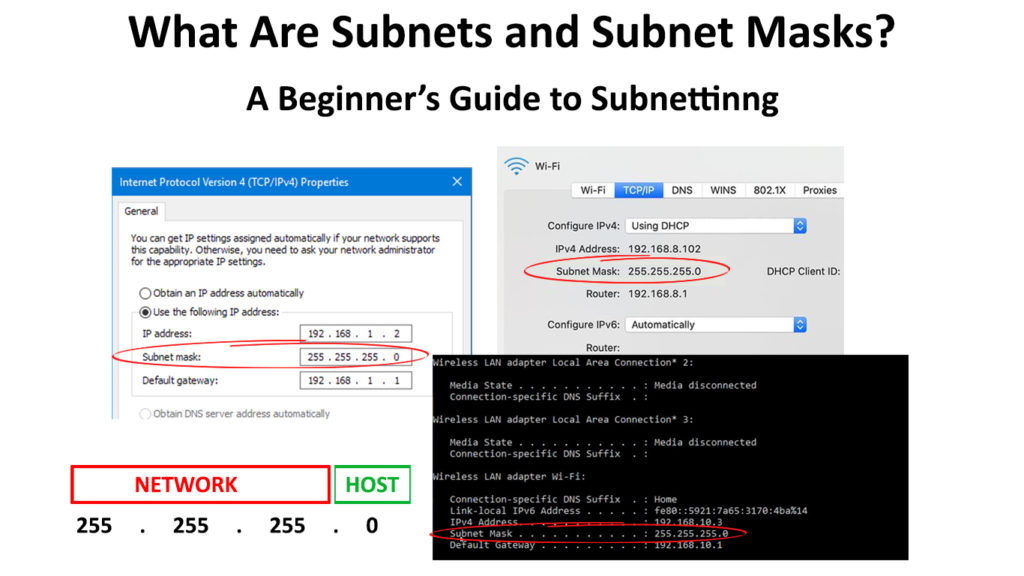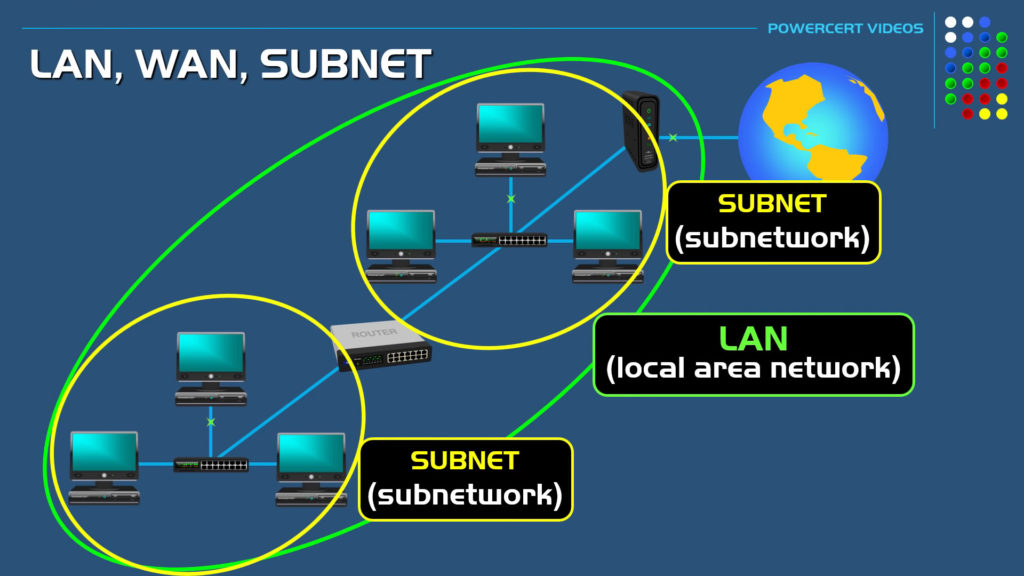Have you ever heard of the terms subnets and subnet masks? If you did, you also probably know they are a must for any larger network. But, why is that? What do these terms even mean? Today, we’ll explain everything you need to know about subnets and subnet masks!

CONTENTS
What is a Subnet?
A subnet is short for subnetwork. As its name states, a subnetwork is a network that’s part of a bigger network. Subnets help networks run more efficiently. That’s because they allow for the network traffic to pass through a shorter distance to reach its destination.

Subnets are smaller networks within a larger LAN network (source –PowerCert Animated Videos YouTube Channel)
If you’ve been reading up on networks and different parts of it, you’ve certainly come across the verb “subnetting”. Subnetting is related to subnets and presents a process of dividing a bigger network into various subnetworks. This process makes it easier for the whole network to function and for the data to pass through as quickly as possible.
Networks Explained – WAN vs. LAN vs. Subnet
Are Subnets and Subnet Masks the Same?
The simple answer is no – a subnet is not the same as a subnet mask. Knowing the difference between these terms will make it easier to understand how networks work and how data flows from one place to another.
So, what is a subnet mask?
To understand what is a subnet mask and why it’s important for the network, we should first go over the meaning of the term “IP address”. An IP address is a unique, 32-bit number that identifies a device on a local network or the internet as a whole. It has information on two important aspects: a host and a network. A host is a device that is used to access the internet, while the network is the actual network where the device is located. In most cases, the device will be found in a subnet.
A subnet mask looks like a regular IP address – it’s a 32-bit address. This number helps differentiate between the host address and the network address which are part of the IP address. It identifies what part of the IP address contains information about the host, and which part is about the network address. Without the subnet mask, these two parts would not be distinguishable. With the help of a subnet mask, the traffic sent to a certain host on a certain network will reach its destination.

The term “mask” is incorporated into the term subnet mask because its main purpose is to mask the network part of the IP address. That way, it reveals how many bits in the IP address are used for the network.
Subnet Masks Explained
Benefits of Using Subnetting
1. The Network Runs More Efficiently
We’ve already mentioned that the main purpose of subnets is to allow a more efficient data flow. The traffic within the network works by allowing data packets to travel through the network to every node. Dividing the network into subnetworks makes the number of nodes smaller, which in turn shortens the routes of data packets. As a result, the data flows more efficiently. That’s especially important within large networks, as too much traffic frequently causes congestion.
Even though you might be unfamiliar with the exact term, the subnetting process is the most logical way to ensure that every action on the network is performed quickly. A network is like a large company that has multiple managers ensuring that the whole business runs smoothly.
If every employee in each rank reported to only one person in the whole company, every decision and every action would go much slower. That is why large businesses always have multiple people operating within different sections. The operation of a business goes much smoother and more efficiently. Subnetting has the same value within a big network.
Subnet masks are also an essential aspect of subnetting. They are there to ensure that all the traffic within a subnet remains in the designated subnet. That way, the effectiveness of the network is undisturbed, while the performance increases.
2. The Administration is Easier
While it may not sound that way, having your network divided into subnets actually makes the process of managing it easier. Many network admins claim that subnetting makes it easier to monitor devices on a network. That way, any issue can be detected and mitigated more quickly. Thus, the troubleshooting process is also much quicker. Still, even though it can be time-saving in the long run, it’s crucial to keep in mind that subnetting does take careful planning and setting up.
In addition, subnetting can save you from wasting IP addresses. Subnetting can help you make the most of one public IP address and avoid the hustle of being mindful of the IP address classes. Instead of having an IP address for each device on the network, you could have multiple private IP addresses on a single network.
3. The Network is Less Prone to Threats
If you have every device operating within one larger network, any security issue would affect the whole network. On the other hand, having a subnetwork within the large network means that a potential problem will only affect the subnet in which it happened. In most cases, an attacker won’t be able to access the information about the other subnets on the network, which means that the rest of the subnets would be secure.
What’s more, subnets allow you to control the access of other devices to the information on the network. Sometimes, a threat can be found within the network. That is why it’s wise to create subnets and restrict access to sensitive information in one subnet from devices in another. Controlling the flow of the traffic with the help of QoS and ACLs within subnets is also a useful option to have.
The Bottom Line
Subnets and subnet masks can make the process of managing and protecting the network much easier. While they aren’t the easiest to understand, they are definitely worth investing your time in. Subnetting will help you with network administration and enable it to run more efficiently. Finally, your network will be more secure!

Hey, I’m Jeremy Clifford. I hold a bachelor’s degree in information systems, and I’m a certified network specialist. I worked for several internet providers in LA, San Francisco, Sacramento, and Seattle over the past 21 years.
I worked as a customer service operator, field technician, network engineer, and network specialist. During my career in networking, I’ve come across numerous modems, gateways, routers, and other networking hardware. I’ve installed network equipment, fixed it, designed and administrated networks, etc.
Networking is my passion, and I’m eager to share everything I know with you. On this website, you can read my modem and router reviews, as well as various how-to guides designed to help you solve your network problems. I want to liberate you from the fear that most users feel when they have to deal with modem and router settings.
My favorite free-time activities are gaming, movie-watching, and cooking. I also enjoy fishing, although I’m not good at it. What I’m good at is annoying David when we are fishing together. Apparently, you’re not supposed to talk or laugh while fishing – it scares the fishes.
